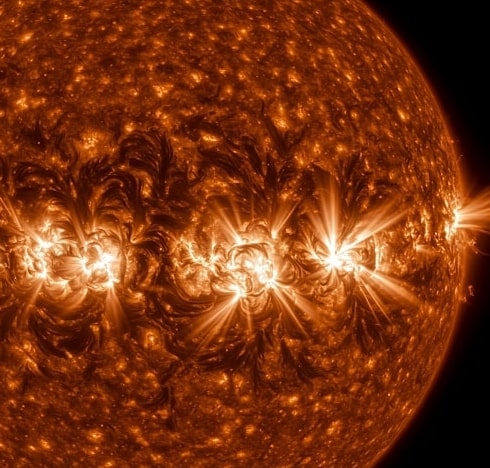In the long tradition of exploring physical phenomena through both mathematics and conceptual innovation, the question of whether the photon possesses mass continues to serve as a pivotal reference point. The assumption of massless photons has guided the architecture of electromagnetic theory since Maxwell’s time, yet by carefully examining the consequences of attempting to ascribe or disprove a rest mass to the photon, new conceptual insights arise. Chief among them is the framework for understanding negative effective mass—a property distinct from the concept of negative mass itself, but no less radical in its implications. This article extends the tradition of intellectual exploration in physics by grounding the discussion in a narrative of higher-dimensional differences, the invariance of the photon in motion, and the necessity of extending Maxwell’s equations to encompass new domains of inquiry.
Mirror symmetry, originally a concept rooted in string theory, provides an unexpected lens through which to view the physics of photons and effective mass. At its heart, mirror symmetry teaches us that two seemingly different geometrical configurations can yield equivalent physics. Applying this intuition to photonic principles, one might argue that our conventional 3+1 dimensional world—three spatial dimensions and one temporal—represents only one face of a broader mirror-like structure. In higher dimensions, the symmetries governing photon behavior may shift, allowing for phenomena such as negative effective mass to manifest naturally.
By conceptualizing the photon as a massless entity moving through a layered dimensional landscape, we encounter the paradoxical reality that higher-dimensional structures can permit behaviors that would appear impossible or unstable in our lower-dimensional view. Mirror symmetry thus frames negative effective mass not as an exotic anomaly but as a natural shadow of higher-order laws of physics. These conceptual translations suggest that new physical laws are not so much invented as revealed, like reflections of deeper symmetries across invisible dimensions.
The disproof of photon mass strengthens this view. If photons were to have any rest mass, mirror symmetry would demand complementary adjustments in higher-dimensional theory that could destabilize the delicate equivalence of observed and hidden geometries. The fact that photons remain invariant under scrutiny—always massless—becomes a cornerstone for treating effective mass as a derived, not fundamental, property. Hence, mirror symmetry leads us into a perspective where negative effective mass may be regarded as an emergent consequence of dimensional mirroring, rather than a violation of physical law.
Supersymmetry (SUSY) extends this line of thought by suggesting that every known particle has a partner particle, related through a symmetry that connects matter and force. Within this framework, the photon’s hypothetical partner, the photino, carries implications not just for particle physics but for how effective mass might be conceptualized across bosonic and fermionic systems. If photons remain massless while their superpartners behave differently under symmetry-breaking conditions, then effective mass—positive or negative—becomes a tool to describe emergent dynamics across the SUSY landscape.
When we speak of negative effective mass, we are not invoking exotic matter that defies gravity outright, but rather describing the peculiar ways in which quasiparticles, excitations, or modes within a system may respond to forces in an inverted fashion. Supersymmetry helps to situate this behavior as part of a broader pattern, where underlying invariances guarantee stability even in the face of what appear to be paradoxical behaviors. The disproof of photon mass underscores this: since the photon does not break symmetry by acquiring mass, the structures that allow negative effective mass remain purely effective and emergent, consistent with the symmetry principles of SUSY.
Thus, SUSY supports a narrative where negative effective mass is not a fringe phenomenon but a predictable aspect of systems governed by hidden but rigorous symmetries. It reinforces the idea that when we extend Maxwell’s equations, we are not discarding their power but embedding them in a richer, more complete framework of nature.
To clarify: negative effective mass is not the same as negative mass. Negative mass, as a speculative concept, would entail matter that accelerates in the opposite direction of an applied force—a notion fraught with paradoxes and contradictions. Negative effective mass, by contrast, describes the behavior of particles or quasiparticles within a medium when their dynamic response to forces mimics this inverted relationship without requiring a violation of fundamental laws.
Consider how electrons behave in certain solid-state systems. Within a lattice, the curvature of energy bands can produce scenarios where the effective mass becomes negative. This does not mean the electron has acquired a literal negative mass; it means that the collective interactions within the system give rise to motion that, in certain contexts, behaves as though the mass were inverted. By studying photons under similar conditions, we see how light, too, may exhibit effective dynamics that challenge conventional expectations.
The masslessness of the photon becomes essential here. If photons had even the slightest rest mass, the consistency of effective mass dynamics would collapse under contradiction. It is precisely because photons are immutable in their masslessness that we can use them as probes for systems exhibiting negative effective mass. The photon becomes not just a messenger of electromagnetic interactions, but a diagnostic instrument that reveals the layered structure of reality.
Extending Maxwell’s equations becomes an inevitable step in this process. Classical electromagnetism explains much, but it cannot fully capture the subtleties of effective mass in complex media or higher-dimensional contexts. By extending these equations to incorporate new symmetries, interactions, or dimensional considerations, we build the framework necessary to explain how light and matter interact in ways that produce negative effective mass.
Fluid theory offers another fruitful metaphor and analytical tool for approaching negative effective mass. Just as fluids can support vortices, turbulence, and counterintuitive flows, so too can photonic systems support states that respond to forces in reversed or inverted ways. By modeling photons and their interactions as a kind of quantum fluid, we see that negative effective mass emerges naturally in the mathematics of flow and stability.
Again, the disproof of photon mass plays a central role. Were photons to possess mass, the analogy with fluids would break down, as the dynamics of massive particles moving through a medium differ qualitatively from massless excitations. Photons, precisely because they are massless, can behave like the pure carriers of flow that fluid theory presupposes. The study of these flows in higher dimensions reveals entirely new regimes of stability and instability, regimes where negative effective mass arises not as a paradox but as an expected phenomenon of complex flow systems.
Extending Maxwell’s equations in the context of fluid theory helps us capture these insights. Instead of treating light merely as waves in a vacuum, we begin to treat it as a medium that can support higher-order structures. This reframing suggests that effective mass behaviors are not confined to matter but are intrinsic to the dynamics of light itself, especially when guided by higher-dimensional structures.
Schrödinger’s insights into quantum particles provide a natural extension when considering effective mass. When particles are confined to surfaces, or more generally to manifolds, their dynamics change. Constraints alter how momentum and energy relate, which in turn shifts the effective mass. For photons constrained by optical surfaces, waveguides, or dimensional boundaries, the same logic applies: confinement leads to altered dispersion, which can yield negative effective mass regimes.
The invariance of photon masslessness ensures the universality of this effect. No matter how photons are confined, they do not acquire rest mass; instead, their effective mass shifts according to the geometry of the confinement. Higher-dimensional surfaces, when projected down into our familiar space, create scenarios where negative effective mass is the natural outcome. Thus, photons serve as perfect candidates for exploring this phenomenon, precisely because they remain unchanged in their essence even as their effective properties evolve.
Extending Maxwell’s equations once again becomes central. By adapting them to curved surfaces and higher-dimensional geometries, we formalize the relationship between confinement and effective mass. What might appear as exotic behavior in ordinary space becomes ordinary in the expanded language of extended electromagnetism.
Graph polynomials like the Bollobás–Riordan polynomial, while mathematical in nature, provide conceptual tools for describing the complexity of interactions in photonic systems. These polynomials account for embeddings of graphs on surfaces, capturing both topological and combinatorial properties. When applied metaphorically to photonic structures, they illuminate the ways in which connectivity, dimensionality, and symmetry interplay to produce emergent properties such as negative effective mass.
Although the detailed mathematics are reserved for our CERN server publications, the key insight here is that negative effective mass can be understood as an emergent property of highly connected, higher-dimensional systems. The disproof of photon mass provides stability to this picture, since the photon’s invariance ensures that its interactions map cleanly onto the combinatorial structures that graph polynomials describe. The photon, massless and unchanging, threads through the complexity like an invariant, allowing the emergent phenomena to be mapped rigorously.
Maxwell’s equations, when extended to incorporate these insights, provide the physics counterpart to the mathematics of graph polynomials. Together, they build a bridge between combinatorial structure and physical reality, showing how negative effective mass arises not from contradiction but from the richness of interconnection.
Finally, we turn to the notion of dark photon vortex formation. If dark photons exist, their behaviors would mirror certain aspects of ordinary photons while differing in critical respects. The possibility of vortex formation among dark photons raises intriguing questions about how effective mass operates in hidden sectors of physics. Could negative effective mass be not only a property of visible photons in structured media but also a signature of dark-sector dynamics?
Here, the disproof of ordinary photon mass again strengthens the foundation. Massless photons provide a baseline of consistency against which dark photons, if they exist, may be compared. If dark photons acquire effective masses—positive or negative—through interactions in their hidden sector, then studying their vortices could reveal entirely new physics. Maxwell’s equations, extended into dark-sector dynamics, would provide the theoretical framework for interpreting these observations.
Thus, dark photon vortex formation becomes not merely a speculative idea but a testbed for exploring the broader concept of effective mass. By studying these vortices, we might uncover parallels between visible and hidden physics, guided by the invariance of photon masslessness and the conceptual clarity provided by negative effective mass.
References
Anderson, P. W. (1972). More is different. Science, 177(4047), 393–396.
Carroll, S. M. (2004). Spacetime and geometry: An introduction to general relativity. Addison-Wesley.
Gross, D. J., & Witten, E. (1986). Superstring modifications of Einstein’s equations. Nuclear Physics B, 277(1), 1–10.
Peskin, M. E., & Schroeder, D. V. (1995). An introduction to quantum field theory. Westview Press.
Rovelli, C. (2004). Quantum gravity. Cambridge University Press.
Zee, A. (2010). Quantum field theory in a nutshell. Princeton University Press.
Peter De Ceuster. (2025). Theory of Negative Mass.
Excerpt from: Theory of Negative Mass by P. De Ceuster
© All rights reserved. Do not distribute. (Letter: Theory of Negative Mass)

